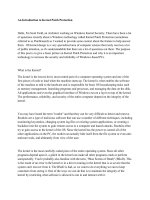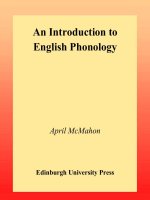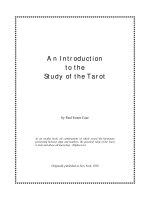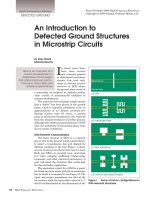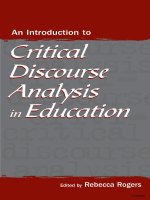Textual Interaction - An Introduction to Written Discourse Analysis-Michael Hoey - 2000 - Routledge
Bạn đang xem bản rút gọn của tài liệu. Xem và tải ngay bản đầy đủ của tài liệu tại đây (3.75 MB, 225 trang )
Textual Interaction
Widely encompassing in its examples and comprehensive in its theoretical
coverage, this important book is full of insights, offers clear methodology,
puts a coherent new position on text, and is, throughout, written in a most
engaging manner.
Gunther Kress, Institute of Education, University of London
Textual Interaction provides a lucid and cogent account of written discourse
analysis.
Hoey clearly sets out his own approach, which focuses on the way writers
and readers interact, and relates it to other approaches. Each chapter
introduces key concepts and analytical techniques, describes important
parallel work, and suggests how to apply the ideas to stylistics and to the
teaching and learning of reading and writing.
In this book, Hoey analyses a wide variety of narrative texts: fairy-tales,
novels, poems, short stories, jokes; and non-narrative texts: posters,
timetables, till receipts. He shows how much these very different text types
have in common with each other and argues that, in the interaction between
writer and reader, the reader has as much power as the writer.
Written in a lively and accessible style, Textual Interaction is suitable for
adoption on text linguistics, applied linguistics, critical discourse analysis,
and stylistics courses.
Michael Hoey is Baines Professor of English Language and Director of the
Applied English Language Studies Unit at the University of Liverpool. His
books include On the Suiface if Discourse and Patterns if Lexis in Text.
Textual Interaction
An introduction to written discourse
analysis
Michael Hoey
London and New York
First published 2001
by Routledge
2 Park Square, Milton Park, Abingdon, Oxon, OX14 4RN
Simultaneously published in the USA and Canada
by Routledge
270 Madison Ave, New York NY 10016
Routledge is an imprint ofthe Taylor & Francis Group
Transferred to Digital Printing 2005
© 2001 Michael Hoey
Typeset in Baskerville by
MHL Typesetting Ltd, Coventry
All rights reserved. No part of this book may be reprinted or
reproduced or utilised in any form or by any electronic,
mechanical, or other means, now known or hereafter
invented, including photocopying and recording, or in any
information storage or retrieval system, without permission
in writing from the publishers.
British Library Cataloguing in Publication Data
A catalogue record for this book is available
from the British Library
Library ofCongress Cataloging in Publication Data
Hoey, Michael.
Textual interaction: an introduction to written discourse analysis!
Michael Hoey.
p.cm.
Includes bibliographical references and index.
I. Discourse analysis. I. Title.
P302 .H557 2000
401'AI-dc21
00-038252
ISBNO-415-23168-X (hbk)
0-415-23169-8 (pbk)
To Mu:m and Dad with love and thanks
Contents
Figures
Tables
Acknowledgements
1
What to expect and what not to expect
Bibliographical end-notes
2
Text as a site for interaction
Introduction
Text as a site of interaction amongst author, writer, audience
and reader
Purposes of the interactions amongst author, writer,
audience and reader
The writer's desire to meet the audience's needs
Signals from writer to reader: moment-by-moment guidance
Clause relations as a reflection of a text's interactivity
Implications for the language learner
Bibliographical end-notes
3
4
Xl
xv
XVI
1
7
11
11
13
15
18
27
30
31
32
35
35
35
Interaction in text - the larger perspective
Introduction
Questions that receive a deferred answer
Signals as messages from writer to reader: previews and
intertextuality
Implications for the language learner
Bibliographical end-notes
43
49
50
The hierarchical organisation of texts
An apology and an introduction
52
52
Vlll
Contents
A reader's larger questions
Texts with a simple hierarchical organisation
The hierarchical organisation of a joke
Setting
A more complicated example: a first visit to Goldilocks and the
Three Bears
A return to Death and the Compass
Bibliographical end-notes
52
53
57
58
The organisation of some 'Cinderella' texts
Introduction
The criminal statute
The text as 'colony'
The definition of a colony
The properties of a colony
Texts classified according to the properties of a colony
The way colonies are read
Implications for the language learner
A footnote
Bibliographical end-notes
72
72
6
A matrix perspective on text
The structure of a happening and its possible tellings
The matrix as a kind of telling
The variable precision of matrices
The matrix analysis of a newspaper story
A matrix perspective on Death and the Compass
An extension of the notion of the matrix
Some implications for language learning
Bibliographical end-notes
93
93
98
100
102
105
109
117
118
7
Culturally popular patterns of text organisation
Introduction
Schemata and scripts
Culturally popular patterns of organisation
The Problem-Solution pattern
The signals of a Problem-Solution pattern
An intermediate stage between Problem and Response
Two advertisements displaying Problem-Solution
patterning
Recycling in Problem-Solution patterns
119
119
119
121
123
125
127
5
62
66
70
73
74
75
77
87
89
90
91
92
128
130
Contents ix
Participant-linking in Problem-Solution patterns
Interlocking patterns in narrative
Summary of the characteristics of Problem-Solution
patterns
Bibliographical end-notes
133
138
140
141
8
Other culturally popular patterns
Introduction
The limitations of Problem-Solution patterning
The Goal-Achievement pattern
The Opportunity-Taking pattern
The Desire Arousal-Fulfilment pattern
The Gap in Knowledge-Filling pattern
A final return to Death and the Compass
One pattern or many?
Some implications for language learning
Bibliographical end-notes
142
142
142
145
150
155
161
164
166
167
169
9
When the pattern turns into a dialogue
Introduction
Question-Answer patterns
Why Question-Answer is different
The relationship of Question-Answer patterns to ClaimResponse patterns
A cline of patterns
Where patterning and interaction meet
A short conclusion
Bibliographical end-notes
170
170
170
176
178
183
184
187
188
Bibliography
Index
189
200
Figures
2.l
2.2
2.3
4.l
4.2
4.3
4.4
4.5
4.6
4.7
4.8
4.9
4.l0
4.l1
4.l2
4.l3
4.l4
6.l
6.2
6.3
6.4
6.5
6.6
6.7
6.8
A representation of the interaction of a reader's expectations and
a writer's sentences.
The interaction of reader's expectations and writer's sentences
where the writer has used some form of prospective signalling.
The interaction of reader's expectations and writer's sentences
where the writer has used some form of retrospective signalling.
The interactivity of text with regard to larger-scale expectations.
The organisation of Aesop and the Travellers.
The hierarchical organisation of A Poison Tree.
Partial hierarchical organisation of a joke.
Fuller hierarchical description of a joke.
Partial hierarchical analysis of Goldilocks and the Three Bears.
Additional layer of organisation for Goldilocks and the Three Bears.
A fuller hierarchical analysis of Goldilocks and the Three Bears.
Another way of representing the hierarchical analysis of
Goldilocks and the Three Bears.
The reader's perception of the organisation of Death and the
Compass.
Another view of the organisation of Death and the Compass.
A third view of the organisation of Death and the Compass.
A fourth view of the organisation of Death and the Compass.
A fifth view of the organisation of Death and the Compass.
The relationship of happening and possible tellings according to
Pike (1981).
An abstract representation of Table 6.l.
The route through the matrix taken by Example 6.l.
An alternative representation of the path taken by Example 6.1.
A matrix analysis of Example 6.2.
A representation of the path taken by Example 6.3.
A revised representation of the relationships among possible
tellings.
The path through the matrix taken by the 'market trader' news
story.
23
27
28
53
56
57
59
62
65
65
66
67
67
68
69
69
69
93
94
95
96
96
97
99
lO4
Xll
6.9
6.10
6.11
6.12
6.13
6.14
7.1
7.2
7.3
7.4
7.S
7.6
7.7
7.8
7.9
7.10
7.11
7.12
8.1
8.2
8.3
8.4
8.S
8.6
8.7
8.8
8.9
8.10
8.11
8.12
8.13
8.14
8.1S
9.1
Figures
The path through the matrix taken by Borges in Death and the
Compass.
The path through Table 6.7 taken by the original teller of the
1\esop' tale.
Pike's matrix seen as the product of interaction of two relations.
The 1\esop' story seen as a product of two relations.
The DENCLEN advertisement seen as a product of two relations.
The passage from Good God seen as a product of two relations.
The Basic Problem-Solution patterns.
The recycling effect of Negative Evaluation in Problem-Solution
patterns.
Analysis of My Love Story.
Simplified analysis of There fMls An Old Woman Who Swallowed a Fly.
Modified representation of range of Problem-Solution patterns
available.
Slightly simplified representation of the Problem-Solution
pattern in No smell garlic.
Participant attribution in No smell garlic.
Overall Problem-Solution patterning of ScotTissue
advertisement.
Participant attribution in the Problem-Solution pattern.
The first Problem-Solution pattern in Bad Sir Brian Botany.
The second Problem-Solution pattern in Bad Sir Brian Botany.
The combined Problem-Solution patterns in Bad Sir Brian Botany.
Analysis of the first seven sentences of Goldilocks and the Three Bears.
Analysis of the 'porridge' episode in Goldilocks and the Three Bears.
Analysis of the 'bed' episode in Goldilocks and the Three Bears.
An impossible interlocking of Goal-Achievement patterns.
A second impossible interlocking of Goal-Achievement patterns.
A possible interlocking of Goal-Achievement and ProblemSolution patterns.
Analysis offirst episode of 'pigsty' joke.
The organisation of the Opportunity-Taking pattern.
A fuller analysis of 'reading the classics' advertisement.
The combination of Problem-Solution and Opportunity-Taking
patterns in Bad Sir Brian Botany.
The combination of Problem-Solution and Opportunity-Taking
patterns in the story of Hagar.
The Desire Arousal-Fulfilment pattern.
Interlocking Desire Arousal-Fulfilment and Problem-Solution
patterns in theJoseph and Potiphar story in Genesis.
A simplified representation of the patterning in Death and the
Compass.
The options available in a SPRE pattern.
The organisation of Chapter I of Master rif Political Thought, Vol. 1.
107
III
112
112
113
114
127
130
132
132
133
134
136
137
138
139
139
140
143
144
144
147
147
148
149
lSI
lS2
IS2
lS3
lS7
161
166
167
173
Figures
9.2
9.3
9.4
9.5
9.6
9.7
9.8
9.9
9.10
9.11
9.12
9.13
9.14
Cohesive links between question (1) and answer (5) in Master if
Political Thought text.
Cohesive links between second answer and reformulated
question in Master ifPolitical Thought text.
Cohesive links between one of the sentences of the second answer
and the original question in Master ifPolitical Thought text.
The basic question-answer pattern.
Pattern of organisation of the political philosophy textbook with
attribution added.
The optional stages in Claim-Denial and Claim-Affirmation
patterns.
Repetition between Claim and Denial in 'Scrapie' letter.
Repetition between Denial and Correction in 'Scrapie' letter.
Repetition between Claim and Correction in 'Scrapie' letter.
An analysis of the political philosophy passage in terms of ClaimDenial.
The relationship of the Question-Answer and Claim-Response
patterns.
Cline of patterns from Problem-Solution to Question-Answer.
A comparison of a possible Question-Answer pattern with a
possible exchange structure.
Xlll
174
174
175
175
176
180
181
181
182
182
183
184
186
Tables
2.1
4.1
4.2
4.3
4.4
5.1
5.2
6.1
6.2
6.3
6.4
6.5
6.6
6.7
6.8
6.9
6.10
Repetition and parallelism in passage from Good God
The parallelism between sentences 1 and 5 of Aesop and the
Travellers
Parallelism between lines 1 and 3 in A Poison Tree
Parallelism between parts of sentences 2 and 5 in a joke
Parallelism among sentences 2, 5 and 8 in a joke
The matching parallelism of sections 1 and 5 of the Badgers Act,
1973
Features of different types of colony
The structure of a 'happening' concerning Abe, Bill and Clara
A broad matrix analysis of Goldilocks and the Three Bears
A fuller matrix analysis of Goldilocks and the Three Bears
A matrix analysis of 'market trader' news story
A matrix analysis of Death and the Compass
A first matrix analysis of the ?\esop' story
An alternative matrix analysis of the ?\esop' story
A matrix analysis of an advertisement for DENCLEN
A matrix analysis of the passage from Good God
An extract from a non-sequence-oriented matrix of Goldilocks
32
55
57
58
58
84
88
94
100
101
103
106
110
III
113
114
116
Acknowledgem.ents
I have been lucky in my life in both personal and academic terms. Academically
this book has benefited greatly from excellent colleagues at each of the three
institutions where I have worked over the years as well as an excellent supervisor
and guide at the beginning of my career. Randolph Quirk, now Lord Quirk, was
my supervisor and he instilled in me a real interest in the English Language and a
respect for data that I have never lost. At the former Hatfield Polytechnic (now
the University of Hertfordshire) I acquired from Eugene Winter an enthusiasm
for discourse analysis and an independence of intellectual spirit; he reinforced also
in me a belief in the centrality of data in any description. His death deprived me of
a loyal friend and fierce critic; this book is the better for having been influenced by
him and the worse for not having been read by him.
At the University of Birmingham I benefited hugely from the friendship and
critical interest of Malcolm Coulthard, John Sinclair, David Brazil, and many
other colleagues. I have sought to reflect their influence upon me in the body of
my text. Again, a passionate commitment to investigating discourse coupled with
respect for what the data were saying was what characterised these linguists.
Malcolm Coulthard's influence went beyond this; it was he that gave me my first
opportunity to publish on the subject of this book and he has been unfailingly
supportive ever since. At one point we intended to write a book on narrative
together: the comments on Borges'Death and the Compass scattered through this
book are remnants of analyses done in preparation of that book and have in all
cases been improved by our discussions together, to such an extent that I cannot
promise that his ideas will not have crept in alongside mine (though defects in the
analyses are indisputably mine alone).
My colleagues at the University of Liverpool, past and present, deserve the
greatest thanks, however. Siobhan Chapman, Lewis Hall, Andrew Hamer, Carol
Marley, Antoinette Renouf, Mike Scott, Nelia Scott, Celia Shalom, Karl Simms,
Geoff Thompson, Sue Thompson and Sarah Waite-Gleave have all been
supportive in every way possible, discussing my ideas with me on every available
occasion, covering for me when I presented papers at conferences that helped me
work through the ideas contained in this book, supplying the many gaps in my
reading and, in Mike Scott's case, giving me free use of his WordSmith software.
To all of them I convey my heartfelt thanks; they will understand, however, if I
Acknowledgements
XVll
reserve still greater thanks to Maureen Molloy who valiantly fights to find me
space to research and write, and unselfishly struggles to keep my working day in
order; in the final days of this book, furthermore, she uncomplainingly responded
to a myriad cries for help in tracing references, finding articles and collecting
together essential information.
I have been greatly helped by staff at Routledge, notably Louise Patchett,
KatherineJacobson and Louisa Semlyen, and also by the project manager, Stuart
Macfarlane, all of whom have been supportive and efficient in equal measure.
The greatest academic thanks must go to my students, both undergraduate and
postgraduate. Indeed without them this book would have been markedly poorer.
I have reluctantly decided that any attempt to thank by name everyone of the
students who has influenced this book would result in invidious and unintentional
omissions. In very many cases, though, they will find their influence explicitly
acknowledged in the bibliographical end-notes to each chapter, and their
anonymity here is no measure of the importance I ascribe to their influence upon
my thinking.
If I have been lucky in my academic life, still more so have I been in my
personal life. The companionship and love of my wife, Sue, has ensured that I
have been able to write my book in a happy and contented state, and no thanks
could be great enough to her. The same goes for my (adult) children, Richard and
Alice, who have allowed me to use their childhood jokes and writings as data in
this book and have prevented me from taking myself too seriously. Likewise I was
blessed with excellent parents, who ensured during periods of extended illness in
my childhood that my studies never suffered and have given me encouragement
and love at all times. To them this book is gratefully dedicated.
The author and publishers would like to thank the following copyright holders for
granting permission to reproduce their material:
Extract from 'Quietly Vanishing' by Malcolm Smith reprinted by permission of
Malcolm Smith and The Independent on Sunday.
The complete text of Well Loved Tales: Goldilocks and the Three Bears retold by Vera
Southgate (Ladybird, 1971) Copyright © Ladybird Books Ltd, 1971. Reprinted by
permission of Ladybird Books Ltd.
Extract from Lexmark advertisement reprinted by permission of Lexmark
International.
While the author and the publishers have made every effort to contact copyright
holders of the material used in this volume, they would be happy to hear from
anyone they were unable to contact.
1
What to expect and what not to
expect
Although it was still early morning, there was already heat in the air. The two
aborigines, members of the Anangu people, had stopped in a patch clear of brush
and the elder of them was crouching on the ground with a stick in his hand with
which he drew in the sand. Behind them in the middle distance loomed the
impressive brick-red shape ofUluru, or Ayers Rock as the Europeans rechristened
it when they finally stumbled upon it. Up the side of it a thin line of climbers could
be seen, like ants on the side of an ant-hill, proving their fitness and their
insensitivity at one and the same time. For Uluru is a sacred site of the Aborigines
and that was why Sue and I were here, bending over the older aborigine as he
drew, trying to learn to see this huge wasteland through his eyes rather than our
own, perhaps trying also, in a way, to atone for the thick skins of the hundreds on
the Rock. As he drew he talked, clearly and loudly but in his own tongue - either
Piuantjatjara or Yankunyuatjara, I had no way of knowing which. That was also
right. His tongue was here long before English, and we needed to know that we
had no right to instant access to his thoughts. We waited expectantly. The drawing
seemed to be a kind of diagram, a diagram to which we did not yet have the key.
All we knew was that he was telling us a story, an ancient legend of his aboriginal
tribe. At last he stopped and the younger man, possibly his son, translated for us in
good English. This is what he said:
In the beginning the Mala people come to Uluru from the north and the west
to participate in an Inma, a religious ceremony. In preparation for that
ceremony the young men, the old men, the young and unmarried women
and the old and married women all set up separate camps. Some of the men
carry a ceremonial pole, Ngaltawata, up to the top ofUluru where they plant
it in the northernmost corner. This signals the beginning of the ceremony and
everything they do from now on will become part of the ceremony; even the
most menial tasks must be done in a manner appropriate to the ceremony.
While the Mala are busy about their ceremony, happy in what they doing,
people arrive from the west with an invitation to join another Inma. The Mala
have no choice but to refuse as a ceremony once started cannot be stopped in
the middle. This is, however, a great insult to the people from the west and they
return home angry, determined to take revenge upon the Mala for the insult.
2
What to expect and what not to expect
Accordingly they create an evil, black dog-like creature called Kurpany to
destroy the Mala people's ceremony. As Kurpany heads for Uluru, Lunpa the
kingfisher flies ahead and tries to warn the people but his warning is ignored.
Kurpany arrives at the ceremony and destroys it, killing many of the Mala
men, women and children. The survivors flee terrified to the south pursued
all the way by Kurpany.
With that he fell silent. The story was at an end. He pointed to the line of tiny
figures climbing Uluru, testing their fitness against the steepness of the Rock. 'We
call them Minga - that is our word for ants', he said. 'Where they are climbing is
where the Mala men climbed to put the ceremonial pole.' We nodded, ashamed
but also a little smug. We had avoided a long and arduous climb in the heat and
at the same time conformed with the religious sentiments of the people who were
the traditional owners ofUluru.
Academic books are not narratives and they do not begin in media res. I have
therefore broken a fundamental convention of academic textbook writing by
beginning the way I just have, and my first purpose in so beginning was to draw
attention to the existence of such conventions. Had this book been entitled In
Search qfthe Inner Australia, there would have been nothing surprising about the first
page at all. Travel books are characteristically narratives and may choose to begin
wherever they like. Academic textbooks and travel books belong to different genres
and a full survey of text analysis needs to take account of the conventions that
govern such genres with varying degrees of rigidity. Key figures in such work are
Swales (e.g. 1990), Hasan (e.g. Halliday and Hasan 1985) and Martin (e.g. 1997). It
is not easy to define genre and some definitions would cover the academic
textbook more readily than the travel book. But the existence of genre as a key
feature of text can hardly be denied and affects little linguistic matters as well as
large. So the beginning of this chapter is predominantly in the past tense, except
where the translator of the story is being quoted, and is organised around time
sequence. The remainder of the chapter on the other hand is overwhelmingly in
the present tense and makes little use of time sequence.
You might imagine from the preceding paragraphs that this book was going to
be about genre. But this book does not pretend to provide a description of genre
structure, important though genre is. The above paragraphs were a confession of a
failure to cover genre, not a promise to do so. Throughout the book references will
be made to different genres and in a number of places an attempt is made to
correlate these genres with some of the features found to characterise texts, but
no theory of genre is outlined, nor are any connections stronger than correlations
proposed. At the end of this chapter, however, will be found a bibliographical note
in which some of the key works on genre are cited, and readers are invited to follow
up these leads. Such bibliographical notes will be found at the end of each chapter;
in this way the main text need not be encumbered with the machinery of extensive
citations, but scholarly proprieties are properly maintained and my innumerable
debts to other linguists can be paid.
What to expect and what not to expect
3
Look again at the 'travel book' beginning and ponder for a moment what the
discourse is saying. On the face of it, it is an account of an encounter in central
Australia between the members of two cultures, one alien, one native, in which
the visitors learn something of the native culture. But the story is less transparent
than it seems. To begin with, as I have already noted, it conforms pretty closely to
the norms associated with travel writing, which are, of course, norms associated
with the alien culture, not the aboriginal one. In some sense, then, the aboriginal
experience has simply been (ab)used as exotic fodder for an established western
genre. There is no sense in which the cultural encounter has altered the discourse
in which it is reported.
Secondly, although the visitors are reported as being sympathetic to and
respectful of the aboriginal beliefs, the story begins and ends with the words of
the narrator (me). It is the narrator who has the final word, not the Anangu
translator. This is another way in which I have incorporated his words and world
into mine. Look, too, at the distribution of grammatical subjects: one or other of
the aborigines are the subject of thirteen clauses, my wife and I are subject of
exactly the same number of clauses, once non-finite and coordinated clauses are
taken into account. In other words the story is about us as much as them. In
retrospect the story is as much about our giving them something - atonement,
respect - as it is about their giving us something. It is not, as it could have been, a
story about injustice and colonial oppression.
A vigorous branch of text linguistics at the present time is that devoted to what is
termed critical discourse analysis. This approach to the analysis of text is concerned to
unpack the political, social and cultural implications of the texts that we
encounter (and produce). The traditional text linguist, in ignoring these
implications, can be seen as conspiring to keep them hidden and thereby supports
whatever status quo the texts are a cultural product of; the critical discourse
analyst seeks to uncover such implications and thereby to make possible a
challenge to the status quo.
As with genre, so with critical discourse analysis, as far as this book is
concerned. On occasion, where appropriate, social/cultural implications are
drawn out, particularly when correlations with genre are being made, and I have
attended to any features of texts whose status quo positioning I am particularly
anxious not to endorse; but in general this book does not offer critical discourse
analytical insights in any systematic way, despite the current importance of this
branch of text linguistics to the field as a whole. The bibliographical section of this
chapter therefore offers a brief range of references for those who would like to
explore further this aspect of text linguistics.
My third purpose in beginning the book the way I did was that I wanted you to
read the aboriginal story. Although it is risky to make sweeping assumptions
about reader reactions, I suspect that the story will seem strange to many readers,
particularly those who have grown up or been educated within what might be
termed the Graeco-Roman tradition that has so profoundly influenced the
cultures of Europe and North America. It flouts our expectations about storytelling. It is, to begin with, told in the present tense, as if the events described are
4
What to expect and what not to expect
timeless or endlessly repeated. It also pays no attention to establishing a setting. We
are not told who the Mala people were nor who the people from the west were. (Is
it significant, for example, that some of the Mala also come from the west?) Key
questions - or, more properly, questions that I deem key - are left unanswered,
presumably because for the original audience the answers were already known
or irrelevant. But my western mind wants, for instance, to know why the Mala's
refusal to accept the invitation was such a deadly insult and in what way the
people from the west were able to create Kurpany.
Then on a larger scale I am aware of what are (for me) unexpected plot
features. The black dog-like creature Kurpany is described as evil and yet not only
survives but wins. The Mala people are - in my reading - the ones with whom we
sympathise; they try to do things right, there is no malice in their heart in refusing
the invitation of the people from the west, they have done nothing to deserve a bad
fate. The people from the west on the other hand do have bad hearts: they get
angry at being insulted and seek vengeance. Yet it is the Mala who end the story
destroyed, scattered and in terror of their lives. Such a story arising out of the
Graeco-Roman tradition, told in any of the major European languages, might
well have continued to describe how the Mala finally destroyed Kurpany either
by their own devices or with outside help. Alternatively it might have had a
different development, one in which Lunpa the kingfisher had some impact on
their behaviour and they successfully defended themselves against Kurpany.
The point here is that the present book does not assume that the characteristics of English texts apply to other languages. In the course of the book a
number of claims about text organisation will be made but no claim is made
about their applicability outside the English language. It is likely, even probable,
that many of the features described in this book do in fact apply to other
languages, particularly those affected by the Graeco-Roman tradition. In the
course of many of the chapters there is an attempt to apply the analytical features
there described to a complex and endlessly fascinating story by Jorge Luis
Borges, Death and the Compass, which was originally written in Spanish; there
does not appear to be any obstacle to transferring the characteristics of English
texts to this story (though, as we shall see, it challenges some of our assumptions
about text organisation). But the aboriginal text above, and many others from a
wide range of cultures, do not admit so easily of analysis in the same terms as
apply to English texts. Accordingly another important branch of text linguistics
is that devoted to comparing and contrasting the different strategies for
organising texts employed by languages around the world; the term usually used
to describe this field is contrastive rhetoric, following the pioneering work of Robert
Kaplan (1966 et seq.).
Texts establish their own patterns as they develop and this one has already
raised two important areas, only to dampen hopes that they will be covered in this
book. So you will not be surprised to learn that, important as contrastive rhetoric
is, this book makes no systematic attempt to note where the descriptions it
provides apply to other languages nor where other languages would do things
differently. Only in Chapter 7 are there any such comparisons and even here they
What to expect and what not to expect
5
are offered in passing. The bibliographical note at the end of this chapter, however,
contains references to representative works on contrastive rhetoric.
So what does this book attempt to do, if it eschews the description of genre,
makes no claim to offer critical discourse analyses and avoids contrastive
rhetorical description? As mature and experienced readers, it is likely that you
did one of two things when you encountered the travel experience with which this
book began. You may have skipped it altogether to see whether you needed to read
it, or you may have read it with mounting curiosity (or even irritation) at my illmanners in not providing a focus for your reading. If you did not skip the first
page, it is likely that you began to speculate on the uses I might be intending to
make of my experience in Australia. Knowing that this book is about the analysis
of text, you may for example have wondered whether the passage was going to be
used as an example of some textual point. Identifying an unusual narrative as part
of the account, you may have speculated that I was going to draw some
conclusions about the nature of narratives. Noting the reference to the older
aborigine having first told his story in one of the languages of the Anangu, you
might have expected an observation of a comparative linguistic kind. The point
is that you will have interacted with the passage. One of the aims of this book is to
show the linguistic implications of the fundamental fact that texts gain their
meaning from a reader's interaction with them. Had I been a co-operative writer
and introduced the book in the normal way so that you knew what I was
attempting to do and where I intended to go, that would likewise have been
reflected in the wording of my text. The beginning of this paragraph starts with
a question which I then attempt to answer - this, too, is a reflection of the
interactivity of text. The whole of this book is concerned with this topic, but
Chapters 2, 3 and 9 in particular focus on it.
As we shall see in Chapter 3, however, the interactivity just alluded to is not
simple and linear. When I discussed the strangeness to the western mind of the
Anangu story, I treated the story as if it were self-contained. Likewise when I
discussed the critical discourse implications of my own text, I ignored the story as
irrelevant to my purposes. In the latter case I treated the story as an unanalysable
whole; in the former case I treated the surrounding commentary as ifit did not exist.
What this shows is that texts are in part hierarchically organised and that as readers
we may attend to the outer or inner structures at will. Chapter 4 of this book
concerns itself with the mechanics of this property, while Chapters 6 onwards seek
to flesh out the implications in terms of the characteristic patterns of English texts.
Description of these patterns comprises a good proportion of the book. When I
attempted to describe my sense of the oddity of the Anangu story, I made reference
to questions that might have been answered in a western telling and to ways in
which the story might have developed or changed in such a telling. In so doing I
was presuming upon a shared understanding of what texts do, what they are like,
within our culture. This shared understanding is another feature of interactivity
in text and is, more than anything else, the subject of this book. The book attempts,
indirectly, to offer a partial explanation of why the Anangu story seems unfamiliar
by providing an account of what we tend to expect in narratives and other kinds of
6
What to expect and what not to expect
text. So in Chapters 7, 8 and 9, in particular, I attempt to outline some of the main
ways in which narratives and other kinds of text come to feel familiar to us. Some
non-narrative texts, however, are of a very different kind and Chapter 5 attempts
to describe the characteristics of a special class of non-narrative texts which
includes dictionaries, shopping lists and telephone directories.
At this point it is perhaps important to state explicitly something that is implicit
throughout the book. Unlike some linguists, I do not hold that there is a great gulf
fixed between narrative and non-narrative texts, and as the book develops I shall
marshall evidence in support of this view. This in turn relates to my most
important purpose in writing this book. I want to show some of the properties of
texts written in English that underpin all the descriptions of genre and contrastive
rhetoric and make critical discourse analysis possible. In a way, this is a book
about the nuts and bolts of text, the characteristics of text that make them texts
in the first place, and I hope it will find a place alongside the texts cited in the
bibliographical end-notes. The next five chapters in particular describe these nuts
and bolts, and the claims made in these chapters are very tentatively offered as
operating beyond the confines of English.
Although there may be nut and bolt rules that ensure the coherence of text,
beyond these there are, I have argued elsewhere, only conventions. For this
reason, many text-linguists, this one included, seem better able to account for safe
and ordinary texts rather than the ones that most excite. Perhaps that is one of the
reasons why linguistic stylistics has never been seen as a major breakthrough in
literary studies. Despite that, as an ancillary objective of this book, I have
attempted in a few places to draw literary conclusions from text-linguistic
evidence in order to show how a connection might be ventured between literary
criticism and text-linguistics of the kind I advocate.
From the point of view oflanguage learners, on the other hand, the safe and
ordinary texts are likely to be the ones that they encounter first and indeed most
wish to emulate. There are therefore also some language teaching and learning
observations made in the course of each chapter, to indicate the ways in which
the nuts and bolts might help, or be important in, the teaching of English.
I noted above that beyond the 'nuts and bolts' rules there are in my view only
conventions. This leads me to my final reason for beginning this textbook with a
travel experience - to show that it can be done. Text does have patterning, and
genres do conform to conventions, but it is always possible to deviate from the
expected, buck the convention. Text is one of the places where we can show most
creativity. Every statement in this book should be taken as a statement of
description of the norm, not necessarily (or indeed usually) a statement of what
is possible. Nabokov's Pale Fire is a narrative written in the form of footnotes to a
poem; likewise, one of the chapters ofJulian Barnes' Flaubert's Parrot (a narrative or
collection of essays, according to viewpoint) takes the form of an examination
paper. (Of course, linguistic creativity with narrative may take non-discoursal
forms; an example would be Georges Perec's La Disparition, translated, or, more
accurately, re-created in English, as A Void by Gilbert Adair, in which the letter
'e' is avoided for 283 pages.)

